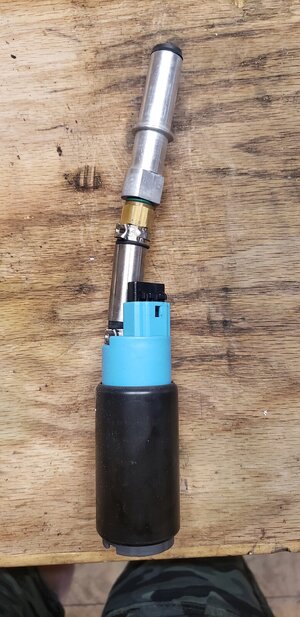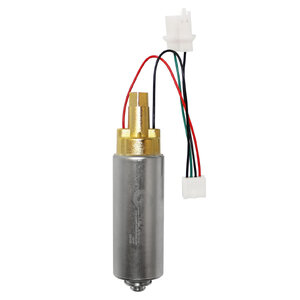Grast5150
Member
Morning Everyone,
I wanted to share my recent experience with my Sea-doo 2001 GTX DI. My youngest drove the ski off the lake telling me it was surging and had no power. As we all know, DI can be a little finicky and they required 107 PSI Fuel Pressure, 80 PSI of Air, and Good Spark. After I took the ski out and noticed the following symptoms.
- No Power
- RPMs no higher than 3500
- Extreme Surging from 2500 to 3500 RPM
- WOT caused engine to die
So, the day was done and took home to diagnose. Once I started the ski, It performed as expected with normal idle and was able to get up to the 6000 RPM range. So......inconsistent Wonderful. My initial thought was something wrong with the Air side as the fuel pump was basically new with less than 40 hours on it. I was also noticing a gurgling noise on the fuel rail. So, I started diagnosing. I first verified the air rail had 80 PSI at start and through throttle range. Air Checked good. The next step was testing Fuel Pressure. The manual states that with key inserted, fuel pump should run and show 27 PSI. I noticed that while pump was running it was at 27 PSI but after 2 seconds it turned off. The fuel pressure immediately started to drop and could hear the gurgle sound. If the rail does not hold pressure before engine start, That is a faulty Fuel Pressure Regulator. I replaced the regulator and resolved the pressure drop. I thought the issue should be solved and took out on the lake. Short story....NO!
Back to testing and more fuel pressure testing. Fuel pressure should be 27 PSI at key insert and 107 PSI +- 2PSI when running. When I tested the ski, All of these numbers were correct, So cant be the fuel pump. On a hunch, I put water on the ski and kept it running. This is when I noticed the true issue. The fuel pump would start off at 107 PSI but after 5 minutes pressure had dropped to 100 PSI and after 10 Minutes dropped to 92 PSI and the engine stalled. So, the fuel pump was the issue. So I pulled it out in order to inspect.
See attached picture. This is a Quantum Fuel System Fuel pump. As you can see it is bent at the fitting which was causing a loss of pressure during operation. My only thought is that movement of the ski with the pressure of the spring caused the fitting to fail. I have to say that Quantum is honoring their lifetime warranty. My goal of this post is that physical inspection of the fuel pump should be done if you have any issues which appear to be fuel related.
Thanks.
I wanted to share my recent experience with my Sea-doo 2001 GTX DI. My youngest drove the ski off the lake telling me it was surging and had no power. As we all know, DI can be a little finicky and they required 107 PSI Fuel Pressure, 80 PSI of Air, and Good Spark. After I took the ski out and noticed the following symptoms.
- No Power
- RPMs no higher than 3500
- Extreme Surging from 2500 to 3500 RPM
- WOT caused engine to die
So, the day was done and took home to diagnose. Once I started the ski, It performed as expected with normal idle and was able to get up to the 6000 RPM range. So......inconsistent Wonderful. My initial thought was something wrong with the Air side as the fuel pump was basically new with less than 40 hours on it. I was also noticing a gurgling noise on the fuel rail. So, I started diagnosing. I first verified the air rail had 80 PSI at start and through throttle range. Air Checked good. The next step was testing Fuel Pressure. The manual states that with key inserted, fuel pump should run and show 27 PSI. I noticed that while pump was running it was at 27 PSI but after 2 seconds it turned off. The fuel pressure immediately started to drop and could hear the gurgle sound. If the rail does not hold pressure before engine start, That is a faulty Fuel Pressure Regulator. I replaced the regulator and resolved the pressure drop. I thought the issue should be solved and took out on the lake. Short story....NO!
Back to testing and more fuel pressure testing. Fuel pressure should be 27 PSI at key insert and 107 PSI +- 2PSI when running. When I tested the ski, All of these numbers were correct, So cant be the fuel pump. On a hunch, I put water on the ski and kept it running. This is when I noticed the true issue. The fuel pump would start off at 107 PSI but after 5 minutes pressure had dropped to 100 PSI and after 10 Minutes dropped to 92 PSI and the engine stalled. So, the fuel pump was the issue. So I pulled it out in order to inspect.
See attached picture. This is a Quantum Fuel System Fuel pump. As you can see it is bent at the fitting which was causing a loss of pressure during operation. My only thought is that movement of the ski with the pressure of the spring caused the fitting to fail. I have to say that Quantum is honoring their lifetime warranty. My goal of this post is that physical inspection of the fuel pump should be done if you have any issues which appear to be fuel related.
Thanks.





